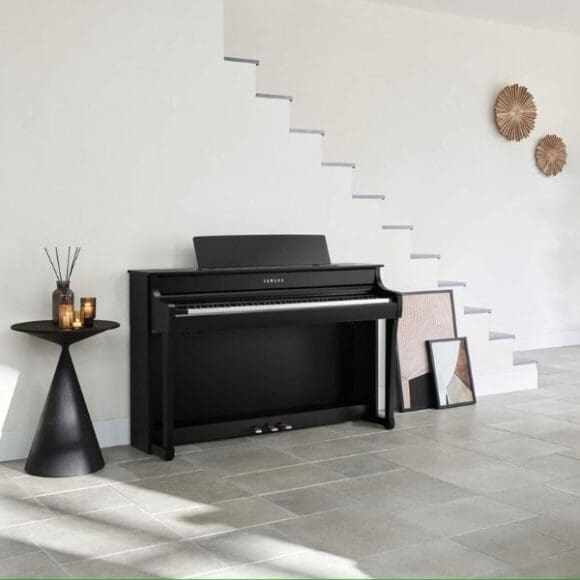
There’s just no getting away from it. Pianos are BIG instruments.
With the best will in the world, even the more compact digital models aren’t portable in the same way that you can swing a guitar onto your shoulder or tuck a neat flute case under your arm.
Moving a piano takes time, energy, and careful consideration. The last thing you want is to risk causing damage. Which is why, at Richard Lawson Pianos, we believe it’s worth taking a moment to think your move through carefully.
Where’s the piano going? How are you getting it there? Who’s doing the lifting? If you’re keen to protect your piano (and your back!) it’s important to plan all aspects of the move. And a great place to start, is by reading through our handy list of the dos and don’ts of piano moving.
The dos of piano moving
-
Protect your piano
Don’t be put off the idea of wrapping up your piano believing that it’s already too bulky and cumbersome. Padding out with old blankets or covering with plastic sheets is a great way to protect the casing and fend off the effects of heat extremities during the move.
-
Remember to clear clutter
And we’re not just talking about lifting off the family picture that sits on the piano lid, decluttering expands further. Whatever path your piano needs to take to get from A-B make sure it’s as clear as possible, and move as much as you can out of the way in advance.
-
Know where it’s going
It may sound obvious but if you’re moving house, have you thought specifically about which room your piano is going to sit in once it arrives at your new home?
When it comes to piano moving, placement is important. You need to consider things such as the surroundings, windows, and room temperature. Take a look at our blog, ‘Where’s the best place to put a piano?’ for more tips.
-
Plan the route
You know the destination but what route will you take to get there? A-roads tend to have fewer twists and turns than B-roads. It’s also worth checking journeys for speed bumps and other traffic calming measures and trying to avoid them where possible.
-
Use a professional piano moving service
Despite their imposing stature, pianos are extremely delicate and complicated instruments. Which is why it’s highly recommended to invest in the help of professional piano movers.
Backed with the necessary skills, knowledge, experience and specialist equipment, using a piano moving service is the best bet to guarantee safe transit and minimise disturbance to your instrument.
-
Book a retune
The physical shifting is only part of the story when it comes to moving a piano. Even when it’s safely in situ, the game isn’t over.
When a piano has been relocated it’s important to have it tuned to ensure everything is rebalanced. Whilst this should be done soon after the move, don’t book it in straight away – wait for 2-3 weeks to allow time for the strings to settle and your piano a chance to acclimatise to its new surroundings.

The don’ts of piano moving
-
Wing it
Proper planning is essential. Nothing strikes fear into a piano lover’s heart quite like the thought of an unplanned move. Not only could this cause irreparable harm to a piano, but it could also inflict costly damage to surroundings and cause injury to those helping out.
-
Change your mind
‘Over here. No, over there!’
The task of moving a piano shouldn’t be undertaken lightly, it’s a heavy instrument. To keep movement to a minimum, decide on the location in advance and stick to it. That way your piano isn’t subjected to unnecessary shuffling from room to room while you ponder where it should go.
-
Forget about the lid
If your lid locks, then make sure you secure it in place to prevent it from opening in transit or banging up and down. If there’s no lock, secure with straps instead. That goes for the fallboard too.
-
Underestimate the size and weight
Pianos aren’t just big, they’re heavy and – particularly in the case of a grand piano – an awkward shape to manoeuvre.
If you’ve previously relied on the castors for a bit of gentle repositioning, don’t be lulled into a false sense of security. The average piano can weigh anything from 300lbs to 1400lbs. That’s equivalent to a fully grown cow – and you wouldn’t attempt to shift one of those without some professional backup now would you?!
-
Use any old moving service
When it comes to moving your pride and joy, why trust any old moving company? Yes, the average removal firm has probably dealt with a piano before but it’s impossible for them to offer the same level of care and expertise as a dedicated piano moving service.
Can a piano be moved upstairs?
With the right skills, equipment – and space – a piano can be moved virtually anywhere.
That said, negotiating up or down steps and stairs understandably adds complications to the process, which is why it pays to involve professional movers. Fully trained, they are best placed to ensure any tricky manoeuvres are done in the safest and most efficient way.
Book your piano move
No one loves pianos more than the team here at Richard Lawson Pianos, which is why it makes sense to use our professional piano moving service. We operate throughout Hertfordshire, London and across the UK, delivering pianos in perfect condition each and every time.
To find out more about what we do, or to arrange a piano move, talk to the team today.















 Reviews
Reviews